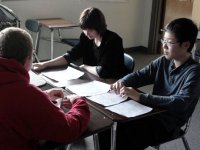Maximizing Profit: The PBL Classroom Without PBL
Your content has been saved!
Go to My Saved Content.Facilitating problem-based learning (PBL) in the classroom requires a shift in pedagogy from a "stand and deliver" class. The problem presented at the beginning of a PBL cycle must create an authentic need for students to develop 21st century skills such as:
- Collaboration
- Communication
- Problem solving
- Reflection skills
A problem we presented in our math classroom is: "How can the student store maximize profit?" This question serves as a strong avenue to facilitate collaboration, meaning that when students try to work alone, it is too hard or too large of a task. PBL requires students to communicate their understanding of the problem, helping them develop critical thinking skills and increasing academic discourse in the classroom. Reflection is also an important part of a PBL cycle. Students should reflect on their process of solving the problem, but also on how collaboration, strong communication skills and thinking critically with peers made the process more manageable. Once students see value in these skills, they can begin making them part of everyday work, whether or not a PBL-focused problem is present.
Take caution, however. These skills are not simply present just because of a PBL cycle -- they must be taught.
Student Collaboration
Once students see a need for collaboration, it becomes the teacher's role to set the foundation. Establishing group norms can be an opportunity for students to become familiar with their peers as learners. As we consider our math problem about maximizing profit, students will have to discuss important vocabulary such as profit and income. Collaboration also provides a space for students to talk about how they will hold each other accountable. Another important aspect is helping them be aware of equity in their group, how are they communicating with others, helping group members to understand their point of view and vice versa. As they think about maximizing profit, students will have to make sure they have a common understanding of the zeros in the parabola representing the "break-even points." After establishing expectations, the teacher must work to maintain high collaboration standards through giving feedback and helping student groups sort out conflict. This can include checking for understanding or facilitating discussions about why everyone in the group hasn't built a common understanding.
Communication
Productive group work involves communicating with team members, a 21st century skill. Communication is also very important when thinking about how the work will be completed, because the workload could become unevenly distributed if group members do not communicate often. Modeling how to ask questions to clarify statements, gain others' perspectives and check for understanding is an important part keeping communication open.
Problem-Solving Skills
Modeling how to solve a problem can be a very powerful way for students to make inferences about what skills are needed. During a problem cycle, teachers can ask questions to help students develop and use their problem-solving skills. For example, teachers could have groups formulate a plan for solving the problem, then ask clarifying questions about both the problem and their process as students work to solve the problem. When thinking about maximizing profit, students will have to work with their group and apply the mathematical definition of a vertex in the context of the problem. This will require students to build understanding about the x-axis representing the number of price changes based on their price interval. It can also build confidence for students to talk about their errors or misconceptions and the process their group used to correct the error. An error may include thinking that the axis of symmetry represents the price change or the price to produce the maximum profit. Ultimately, teachers need to help students recognize the skills they are building throughout the process by being transparent.
Valued Skills Remain in Use
In the video Problems of Practice, I address that, in our Algebra 2 PBL Curriculum Writing Team, we found units where an authentic PBL problem would restructure the unit so that students deepen their understanding of math through a real-life application. For those units where we didn't see a strong fit, we left them as a more traditional curriculum. This is where the shift in pedagogy happens. Just because students are not involved in a PBL unit, such as maximizing profit, doesn't mean that they can't use the skills they have gained through working with their peers.
After establishing a classroom where collaboration, communication and critical thinking skills are valued and used by students, the atmosphere of that classroom changes. I saw this in my own classroom through students asking each other questions and working together without having to be prompted. The skills established though PBL units are more evident. Students are more confident about explaining how they solved a problem, or where their point of confusion lies within solving a problem. The teacher can take on the role of thinking about creating opportunities for students to use their skills through the traditional unit.
Overall, the skills established through PBL units have enriched the classroom, creating more of a team approach to learning, versus a classroom where the teacher is the only source of new information.
